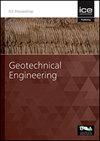用数值方法分析了各种墙体运动模式下的被动土压力
IF 1.7
4区 工程技术
Q3 ENGINEERING, GEOLOGICAL
Proceedings of the Institution of Civil Engineers-Geotechnical Engineering
Pub Date : 2022-04-11
DOI:10.1680/jgeen.21.00199
引用次数: 0
摘要
本文利用FLAC程序(Fast Lagrangian Analyses of Continua)对挡土墙在平移(T)模式、绕底旋转(RB)模式和绕顶旋转(RT)模式下的被动土压力大小和分布进行了数值计算。与经典解一致,结果表明,在T型模式下,被动土压力随深度的分布基本上是静力的。然而,当考虑旋转模式RT或RB时,注意到一个明显的非线性分布,受壁面位移大小的影响很大。对于RT模式,由于拱效应,墙后下半部分土压力增加更为明显,墙体位移对位于墙高普通三分之一以下的被动荷载分布质心影响不大。在RB模式下,随着墙体旋转的进行,墙体上部动员的被动土压力增大,其分布逐渐由非线性变为线性分布。与文献中已有的实验结果相比,RB和RT模式下的被动土压力比T模式下需要更大的位移。本文章由计算机程序翻译,如有差异,请以英文原文为准。
Passive earth pressure under various modes of wall movements by numerical approach
In this paper, numerical computations using FLAC code (Fast Lagrangian Analyses of Continua) are carried out to evaluate the passive earth pressure magnitude and distribution against a retaining wall subjected to different wall movement modes: translation (T) mode, rotation about bottom (RB) mode and rotation about top (RT) mode. In agreement with classical solutions, the results indicate that in T mode, passive earth pressure distribution is substantially hydrostatic with depth for all wall displacement stages. However, when the mode of rotation either RT or RB is considered, a clear non-linear distribution highly affected by wall displacement magnitude is noticed. For RT mode, due to arching effect, the increase of the earth pressure behind the lower half of the wall is more pronounced with wall displacement affecting hardly the centroid of the passive load distribution located bellow the common one-third of the wall height. In RB mode, as the wall rotation progresses, the passive earth pressure mobilized in upper part of the wall increases and its distribution gradually changes from nonlinear to linear distribution. Compared with previous experimental results available in literature, mobilized passive earth pressure in RB and RT modes needs more displacement than T mode.
求助全文
通过发布文献求助,成功后即可免费获取论文全文。
去求助
来源期刊
CiteScore
4.40
自引率
4.50%
发文量
68
审稿时长
3 months
期刊介绍:
Geotechnical Engineering provides a forum for the publication of high quality, topical and relevant technical papers covering all aspects of geotechnical research, design, construction and performance. The journal aims to be of interest to those civil, structural or geotechnical engineering practitioners wishing to develop a greater understanding of the influence of geotechnics on the built environment.

 求助内容:
求助内容: 应助结果提醒方式:
应助结果提醒方式:


